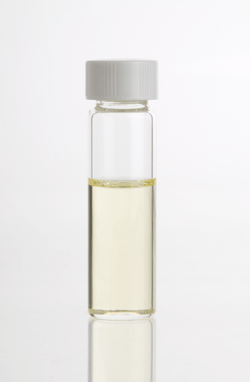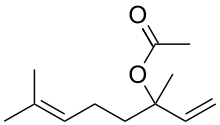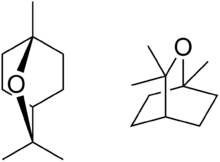Lavender oil

Lavender oil is an essential oil obtained by distillation from the flower spikes of certain species of lavender. Two forms are distinguished, lavender flower oil, a colorless oil, insoluble in water, having a density of 0.885 g/mL; and lavender spike oil, a distillate from the herb Lavandula latifolia, having density 0.905 g/mL. Like all essential oils, it is not a pure compound; it is a complex mixture of phytochemicals, including linalool and linalyl acetate. As of 2011, the biggest lavender oil producer in the world is Bulgaria.[1]
Production
Pure lavender essential oil is produced through steam distillation. This generates a greater amount of oil compared to other methods due to reduction of polar compound loss.[2] Harvest of lavender blooms are typically around June. Lavender flowers are compacted into a still. Fewer air pockets in the still result in greater oil yield. A boiler is then used to steam the bottom of the lavender flower filled still at a very low pressure. The lavender flower pockets containing oil are broken from this heating process and a pipe of cold water is run through the center of the still. The hot lavender oil vapor condenses on the cold pipe with the cold water and is collected into a holding tank where it is allowed to settle. Due to polarity and densities of the water and oil, these two will separate in the holding tank whereupon the water is piped out, leaving just lavender essential oil.[3]
Uses
Lavender oil has long been used in the production of perfume.[4]:184–186
Oil of spike lavender was used as a solvent in oil painting, mainly before the use of distilled turpentine became common.[5]
Lavender oil is used in massage therapy as a way of inducing relaxation through direct skin contact for application.[6]
Adverse effects
Lavender oil appears to be an endocrine disruptor, exhibiting anti-androgenic activity in vitro.[7]
Lavender oils in soaps, shampoos, and other skin applied medications may cause prepubertal gynecomastia, which is breast development in young boys.[8] This suggests that repeated exposure to lavender oil may promote adverse symptoms and effects. These oils can also result in skin irritation and other allergic reactions when in contact with skin, causing nausea, vomiting, dizziness, and overall bodily discomfort.
Consumption of lavender oil in conjunction with other sedatives can lead to detrimental effects on the body. Lavender oil taken with chloral hydrate can cause chronic drowsiness due to exponential buildup of this pharmaceutical sedative.
Composition
The exact composition of lavender essential oil varies from species to species but consists primarily of monoterpeneoids and sesquiterpeneoids. Of these linalool and linalyl acetate dominate, with moderate levels of lavandulyl acetate, terpinen-4-ol and lavandulol. 1,8-cineole and camphor are also present in low to moderate qualities. In all lavender oil typically contains many more than 100 compounds, although a great many of these are present at very low concentrations.[9]
The composition of lavender essential oil as obtained by chromatography:
| Family | Composition | Lavande officinale Lavandula angustifolia |
Lavande aspic Lavandula latifolia |
|---|---|---|---|
| Terpenes / Monoterpenols |
Linalool | 28.92 % | 49.47 % |
| α-Terpineol | 0.90% | 1.08% | |
| γ-Terpineol | 0.09% | ||
| Borneol | 1.43% | ||
| Isoborneol | 0.82% | ||
| Terpinen-4-ol | 4.32% | ||
| Nerol | 0.20% | ||
| Lavandulol | 0.78% | ||
| Terpenes / Terpene esters |
 | 32.98 % | |
| Geranyl acetate | 0.60% | ||
| Neryl acetate | 0.32% | ||
| Octene-3-yl acetate | 0.65% | ||
| Lavandulyl acetate | 4.52% | ||
| Terpenes / Monoterpenes |
Myrcene | 0.46% | 0.41% |
| α-Pinene | 0.54% | ||
| β-Pinene | 0.33% | ||
| Camphene | 0.30% | ||
| (E)-β-Ocimene | 3.09% | ||
| (Z)-β-Ocimene | 4.44% | ||
| β-Phellandrene | 0.12% | ||
| Terpenes / Terpenoid oxides |
 Eucalyptol (1,8-cineol) | 25.91 % | |
| Terpenes / Sesquiterpenes |
β-Caryophyllene | 4.62% | 2.10% |
| β-Farnesene | 2.73% | ||
| Germacrene | 0.27% | ||
| α-Humulene | 0.28% | ||
| Ketones |  Camphor |
0.85% | 13.00 % |
| 3-Octanone | 0.72% | ||
Cryptone | 0.35% |
See also
References
- ↑ Bulgarian lavender producers worried about demand drop, China Post, 14 July 2011
- ↑ Masango, Phineas (2005-06-01). "Cleaner production of essential oils by steam distillation". Journal of Cleaner Production. 13 (8): 833–839. doi:10.1016/j.jclepro.2004.02.039. ISSN 0959-6526.
- ↑ Chanamai, Ratjika; Horn, Gregory; McClements, David Julian (2002-03-01). "Influence of Oil Polarity on Droplet Growth in Oil-in-Water Emulsions Stabilized by a Weakly Adsorbing Biopolymer or a Nonionic Surfactant". Journal of Colloid and Interface Science. 247 (1): 167–176. doi:10.1006/jcis.2001.8110. ISSN 0021-9797. PMID 16290453.
- ↑ N. Groom. New Perfume Handbook. Springer Science & Business Media, 1997 ISBN 9780751404036
- ↑ "Solvent", pp 605-606 in The Grove Encyclopedia of Materials and Techniques in Art, edited by Gerald W. R. Ward. Oxford University Press, 2008 ISBN 9780195313918
- ↑ Fismer, Kate Louise; Pilkington, Karen (2012-12-01). "Lavender and sleep: A systematic review of the evidence". European Journal of Integrative Medicine. 4 (4): e436–e447. doi:10.1016/j.eujim.2012.08.001. ISSN 1876-3820.
- ↑ Henley DV, Korach KS (July 2010). "Physiological effects and mechanisms of action of endocrine disrupting chemicals that alter estrogen signaling". Hormones. 9 (3): 191–205. doi:10.14310/horm.2002.1270. PMC 4782146. PMID 20688617.
- ↑ Henley, Derek V.; Lipson, Natasha; Korach, Kenneth S.; Bloch, Clifford A. (2007-02-01). "Prepubertal Gynecomastia Linked to Lavender and Tea Tree Oils". New England Journal of Medicine. 356 (5): 479–485. doi:10.1056/NEJMoa064725. ISSN 0028-4793. PMID 17267908.
- ↑ Shellie, Robert; Mondello, Luigi; Marriott, Philip; Dugo, Giovanni (2002). "Characterisation of lavender essential oils by using gas chromatography–mass spectrometry with correlation of linear retention indices and comparison with comprehensive two-dimensional gas chromatography". Journal of Chromatography A. 970 (1–2): 225–234. doi:10.1016/S0021-9673(02)00653-2. ISSN 0021-9673.
External links
- http://www.webmd.com/vitamins-supplements/ingredientmono-838-lavender.aspx
- https://medlineplus.gov/ency/article/002711.htm
- Lavender essential oil benefits and uses